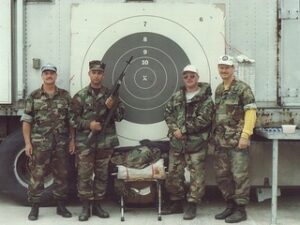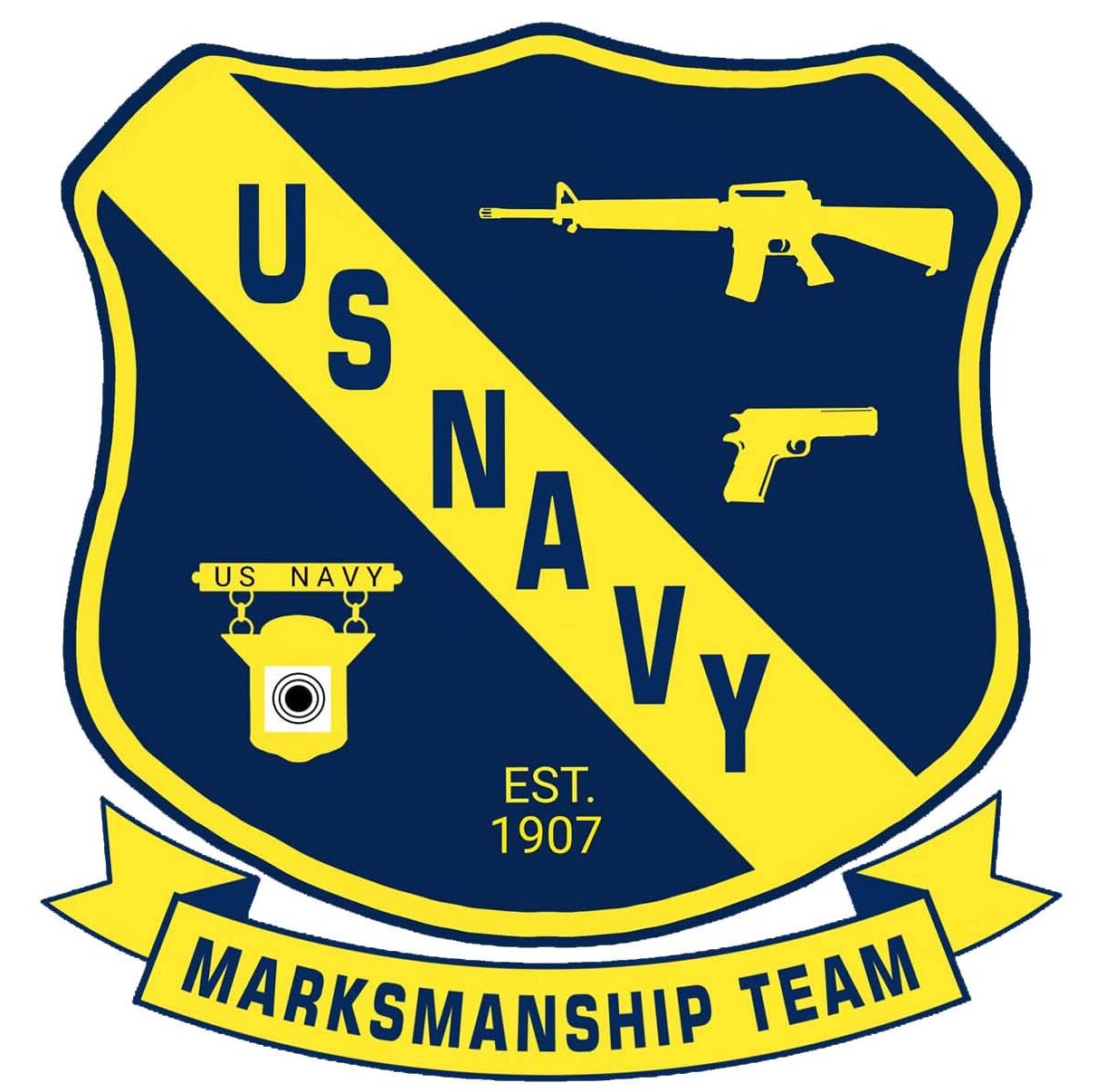Getting started in any shooting discipline involves learning about the rules, firearms, courses of fire, obtaining and wearing proper safety equipment/devices, and finding a place to shoot. An in-depth guide that contains over 40 resources for gun owners such as shooting safety, choosing the correct firearm, shooting basics, competitive shooting, hunting and more, can be found here.
[accordion clicktoclose=”true” autoclose=”false”]
[accordion-item title=”USNMT Matches”]The courses of fire for most military and civilian matches in which USNMT members participate are those that have evolved from matches established by the National Rifle Association (NRA) in the late 1800s and by the National Board for the Promotion of Rifle Practice (now the Corporation for the Promotion of Rifle Practice and Firearms Safety, which administers the Civilian Marksmanship Program, CMP) in the early 1900s, to train large numbers of individuals in the kind of marksmanship needed to be effective on the battlefield, the purpose for which each organization and their respective shooting competitions were established.
Each rifle and pistol match is divided into multiple stages of one of more “strings,” each of which develops and tests the ability of the shooter, against the clock, to achieve a particular shooting position (standing, sitting or kneeling, or prone), achieve a proper sight picture and alignment with the target, control the trigger and breath, and, having adjusted the sights to compensate for target distance and ambient conditions (e.g., wind, light, and temperature), fire a prescribed number of rounds at a stationary bullseye target placed at a “known distance” (KD), with scoring according to a decimal system. The exception is the Infantry Team Trophy (rifle) Match, which uses silhouette targets scored on a hit/miss basis. In certain rifle match stages, the shooter is required to execute an ammunition magazine change (or, in the case of the M1 rifle, a change of its block ammunition clip) during the firing sequence.
While no course of fire addresses every skill that an individual might require in combat, traditional KD, across-the-course, courses of fire develop and test the individual’s mastery of the fundamentals of marksmanship and, particularly, combat-related marksmanship. Importantly, they do so in events in which large numbers of individuals may participate, an imperative from the standpoint of training Americans for national defense purposes.
The Navy and Marine Corps continue to use the traditional NRA and CMP courses of fire for regular training, as well as for marksmanship competitions. By contrast, the Army trains regular troops by having them shoot at relatively short distances at “pop-up” targets — an approach that has generated much controversy among skilled marksmen and others concerned about the ability of our soldiers to survive on the battlefield.[/accordion-item][accordion-item title=”Official Rulebooks”]Rulebooks for the various disciplines described below can be found at the NRA and CMP. Reference the rulebooks for the most up-to-date description of allowed firearms, equipment, and courses of fire.[/accordion-item]
[accordion-item title=”High Power Rifle aka Across the Course (XTC) Matches”] Highpower rifle matches are conducted by both the NRA and CMP. There are rule differences (especially with regards to sighting shots and the rapid fire stages) between the two bodies, so know which rules govern the match you are competing in (stated in the match program) and review the appropriate rules.
Most individual and team matches use the 50-shot NRA National Match Course (NMC), 80-shot NRA Regional Match Course (RMC), or CMP Service Rifle equivalent. These events are referred to as “across the course” matches, because they are shot at a variety of distances from the target. Each match, with the exception of the CMP’s three-stage President’s Match, has four stages:
Standing, 200 yds., slow-fire (10 shots in 10 minutes)
Sitting or kneeling, 200 yds., rapid-fire (10 shots in 60 seconds)
Prone, 300 yds., rapid-fire (10 shots in 70 seconds)
Prone, slow-fire, (20 shots in 20 minutes)
For the NRA NMC, the first three stages are doubled. For the CMP President’s Match, the sitting stage is omitted and the 600 yard stage is only 10 shots.
An overview of the courses of fire and marksmanship fundamentals is found here (updated 2022).
A short history of the National Trophy Team rifle match can be found here.
A short history of the President’s Match and the President’s Hundred can be found here.[/accordion-item]
[accordion-item title=”CMP National Trophy Infantry Team Match (NTIT)”] The Infantry Team Match (ITT) is also known as the “rattle battle” because of the high rate of fire and the number of shooters firing simultaneously. This event is fired prone, rapid fire, at 600 and 500 yards, sitting at 300 yards, and standing at 200 yards, with the Service Rifle. Teams are composed of six shooters plus a Captain and a Coach. While other matches are fired on decimal-score bullseye targets, the ITT is fired upon silhouette targets. See the CMP for specific information about these types of matches. An interesting history of the ITT can be found here.[/accordion-item]
[accordion-item title=”NRA High Power Long Range”]Long Range Rifle events are fired in the prone position, slow-fire (20 rounds in 20 minutes) and are fired at 600 and/or 1,000 yards. USNMT members compete in either the Service Rifle category or the “any rifle/any sight” category, with special-purpose, telescopically-sighted .300 Winchester Magnum bolt-action rifles built by Armorers at Naval Surface Warfare Center, Crane Division.
The Palma Match, an NRA National Championships event, is shot at 800, 900, and 1,000 yards, with 15 rounds at each stage. Shooters compete in one of three categories: Service Rifle, NRA Match Rifle, or Palma Rifle. In international Palma matches, only Palma Rifles and ammunition loaded with projectiles less than 156 grains are allowed to be used. For more information about shooting Palma in the US, see here. For information about the history of the Palma Trophy and Matches, see here.
Fullbore matches are similar to Palma matches, but have different rules and are fired in the prone distance at 300, 500, 600, 900, and 1000 yards on a tighter (smaller diameter scoring rings). Only .223 caliber (with projectiles less than 81 grains) and .308 caliber (with projectiles less than 156 grains) are allowed. For more information about Fullbore shooting and its rules, see here.
 Learn the story of how a new shooter became the Farr Trophy winner during the 1999 National Long Range Championships. [/accordion-item]
Learn the story of how a new shooter became the Farr Trophy winner during the 1999 National Long Range Championships. [/accordion-item]
[accordion-item title=”NRA Conventional (aka Precision or Bullseye) Pistol”]Bullseye Pistol events test the ability of the shooter to fire from a standing position with the pistol held in one hand. A course of fire consists of 90 shots per pistol type: .22 rimfire pistol, centerfire pistol (.32-.45 caliber), and .45 caliber. Note a .45 caliber pistol can be shot for both the center fire and .45 caliber event. The 90 shots are broken out as follows:
- Slow Fire Stage: 50 yards, 10 shots in 10 minutes;
- National Match Course: 10 shots slow fire; then 10 shots timed fire; then 10 shots rapid fire;
- Timed Fire: 25 yards, two five-shot strings, each in 20 seconds;
- Rapid Fire: 25 yards, two five-shot strings, each in 10 seconds.
The National Pistol Championship includes a 270-shot aggregate of 90 shots each with .45 caliber Sesrvice Pistol, any centerfire pistol, and .22 rimfire pistol. The Nationals are normally conducted over several days and also include a Service Pistol event (90 shots with a service pistol) and a Distinguished Revolver event (30 shots with a revolver). A short history of the National Trophy Individual (NTI) pistol match can be found here.
A guide for how to train for and shoot bullseye pistol is found here.
Precision shooting and its sister sport Air Pistol programs can be high schools and colleges across the United States. The Olympic Games host variations on precision pistol and air pistol competitions. [/accordion-item]
[accordion-item title=”Other Target Shooting Disciplines”]There is an almost unlimited variety of rifle and pistol target shooting disciplines today. Some of the more popular are listed below, in alphabetical order:
Fifty-Caliber Long Range — Shooters use target rifles chambered for the legendary .50 caliber Browning Machine Gun cartridge in 1,000-yard matches. The Fifty-Caliber Shooters Assn. has approximately 1,900 members and is growing steadily. It provides a service to military and law enforcement with research and instruction.
Action Pistol — Action Pistol matches are similar to IPSC and IDPA matches and combine speed and accuracy while shooting at multiple targets. The minimum power pistol used is 9mm NATO. All events require a competitor to start with a holstered pistol and, on command, draw and fire at one more targets.
International Defensive Pistol — Shooters use regular-grade (not match-grade) pistols firing full-charge service ammunition in simulated “real world” self-defense scenarios. Contact the International Defensive Pistol Assn. for more details.
International Practical Shooting — Shooters must accurately fire a handgun of 9mm NATO caliber or larger against the clock, at relatively close range, at multiple targets, moving targets, and targets that react when hit, while negotiating obstacles and other challenges. Contact the International Practical Shooting Confederation for more details.
Smallbore Rifle — “Smallbore” refers to firearms chambered to fire .22 rimfire ammunition. Smallbore rifle competition is held over distances of 50 feet, 50 yards/meters, and/or 100 yards. Match competition can be as quick as 30 shots (10 shots prone, standing, kneeling) in a league or as long as 40 shots at the National Championships. Competition is conducted in as many as four positions – prone, sitting, kneeling, and standing. The Olympic Games host smallbore rifle competitions.
Air Gun – In modern competition, air guns, whether pistol or rifle, are .177 caliber pellets. A history of air guns can be found here. The most popular form of air rifle shooting is 3-position. It is styled after smallbore rifle. and programs exist in high schools and colleges across the United States. It is also popular in many youth organizations such as the Boy Scouts and the American Heritage Girls. The Civilian Marksmanship Program hosts an air rifle program as well. Finally, the Olympic Games host all standing position air rifle competitions. Air Pistol is shot in multiple formats at colleges as well as at the Olympics. USA Shooting conducts the National Junior Olympic Program for air guns – rifle and pistol. [/accordion-item]
[/accordion]
